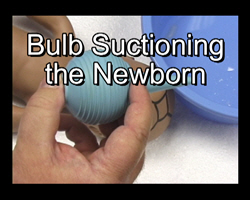|
The bulb syringe
is readily available, safe tool for clearing the airway of a newborn
infant. This
short, free video demonstrates, on a model and a live patient, this
use of the bulb syringe.
Bulb Syringe Aspiration
Runtime 0:42 Min
1.8 MB wmv
Download Now |
|

Suction the
Airway
When babies are born, they need to clear the mucous and amniotic
fluid from their lungs. Several natural mechanisms help with this:
- As the fetal chest passes through the birth
canal it is compressed, squeezing excess fluid out of the lungs
prior to the baby taking its' first breath. This is noticed most
often after the fetal head is delivered but prior to delivery of the
shoulders. After several seconds in this "partly delivered"
position, fluid can be seen streaming out of the baby's nose and
mouth.
- After birth, babies cough, sputter and
sneeze, mobilizing additional fluid that may be in their lungs.
- After birth, babies cry loudly and
repeatedly, clearing fluid and opening air sacs in the process.
Crying is a reassuring event and does not indicate distress.
- Newborn grunting actions may further mobilize
fluid, in addition to opening the air sacs in the lungs.
While babies will, for the most part, bring the
amniotic fluid out of the lungs on their own, they may need some
assistance in clearing their airway of the mobilized fluid. This will
require suctioning.
Bulb syringes are commonly used for this
purpose, suctioning both the nose and mouth of the baby. If a bulb
syringe is not available, any suction type device may be used,
including a hypodermic syringe without the needle.
If no suction device is available, keep the baby
in a slight Trendelenburg position (head slightly lower than the feet)
and turn the baby to its' side to allow the fluids to drain out by
gravity.
From OB-GYN 101: Introductory Obstetrics & Gynecology |

